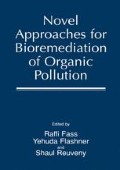Abstract
One of the major environmental problems facing the military establishment is the considerable amount of land and water that is contaminated with explosives, particularly TNT (2,4,6-trinitrotoluene). Explosives are found in the environment as a result of waste water produced by manufacturing plants and from the disposal of off-specification material or demilitarisation of out-of-date munitions. Concerns have arisen regarding the toxicity and environmental fate of TNT and nitrate ester explosives such as PETN (pentaerythritol tetranitrate) and GTN (glycerol trinitrate) due to their relative toxicity. PETN and GTN are produced in large amounts for use as explosives in blasting caps and detonators and as vasodilators for the control of angina. Nitrate esters are extremely rare in nature and multiply-substituted nitrate esters are not known to occur naturally. The environmental fate of such compounds which are produced in large quantities by the chemical industries, is therefore of considerable interest. In this paper we describe the isolation and characterisation of a strain of Enterobacter cloacae from explosives contaminated soilt that is capable of utilising nitrate ester explosives and TNT as sole nitrogen sources for growth.
Access this chapter
Tax calculation will be finalised at checkout
Purchases are for personal use only
Preview
Unable to display preview. Download preview PDF.
References
Binks, P. R., French, C. E., Nicklin, S. and Bruce, N. C. (1996). Degradation of pentaerythritol tetranitrate by Enterobacter cloacae PB2. Appl. Environ. Microbiol. 62:1214–1219.
Cleland, W. W. (1970). Steady state enzyme kinetics, p1–65. In P. D. Boyer (ed.), The enzymes, 3rd ed., vol. 2. Academic Press, N.Y.
Fox, K. M. and Karplus, P. A.. (1994). Old yellow enzyme at 2 A resolution: overall structure, ligand binding, and comparison with related flavoproteins. Structure 2:1089–1105.
French, C. E. and Bruce, N. C. (1995). Bacterial morphinone reductase is related to old yellow enzyme. Biochem. J. 312:671–678.
French, C. E., Nicklin S. and Bruce, N. C. (1996). Sequence and properties of pentaerythritol tetranitrate reductase from Enterobacter cloacae PB2. J. Bacteriol. 178:6623–6627.
French, C. E., Nicklin S. and Bruce N. C. (1998). Aerobic degradation of 2,4,6-trinitrotoluene by Enterobacter cloacae PB2 and by pentaerythritol tetranitrate reductase. Submitted for publication.
Genetics Computer Group. (1994). Program manual for the Wisconsin package, version 8, September 1994. 575 Science Drive, Madison, WI, USA.
Haïdour, A. and Ramos, J. L. (1996). Identification of products resulting from the biological reduction of 2,4,6-trinitrotoluene, 2,4-dinitrotoluene, and 2,6-dinitrotoluene by Pseudomonas sp. Environ. Sci. Technol. 30:2365–2370.
Kaplan, L. A. and Siedle, A. R. (1971). Studies in boron hydrides IV: stable hydride Meisenheimer adducts. J. Org. Chem. 36:937–939.
Leatherbarrow, R. J. (1990). GraFit version 2.0, Erithacus Software Ltd., Staines, U.K.
Rosenblatt, D. H., Burrows, E. P., Mitchell W.R. and Parmer, D. L. (1991). Organic Explosives and Related Com-pounds. In The Handbook of Environmental Chemistry. Edited by O. Hutzinger. Springer,Verlag.
Sambrook, J., Fritsch, E. F. and Maniatis, T. (1989).Molecular cloning: a laboratory manual,2nd ed.Cold Spring Harbor Laboratory Press, Cold Spring Harbor,N.Y.
Schopfer, L. M. and Massey, V. (1991). Old yellow enzyme, p. 247–269. In S. A. Kuby (ed.), A study of enzymes. CRC Press, Boston.
Vorbeck, C., Lenke, H., Fischer, P., Spain, J. and Knackmuss H.-J. (1998). Initial reductive reactions in aerobic microbial metabolism of 2,4,6-trinitrotoluene. Appl. Environ. Microbiol. 64:246–252.
Author information
Authors and Affiliations
Editor information
Editors and Affiliations
Rights and permissions
Copyright information
© 1999 Springer Science+Business Media New York
About this chapter
Cite this chapter
French, C.E. et al. (1999). The Degradation of Nitrate Ester Explosives and TNT by Enterobacter Cloacae PB2. In: Fass, R., Flashner, Y., Reuveny, S. (eds) Novel Approaches for Bioremediation of Organic Pollution. Springer, Boston, MA. https://doi.org/10.1007/978-1-4615-4749-5_7
Download citation
DOI: https://doi.org/10.1007/978-1-4615-4749-5_7
Publisher Name: Springer, Boston, MA
Print ISBN: 978-1-4613-7153-3
Online ISBN: 978-1-4615-4749-5
eBook Packages: Springer Book Archive

